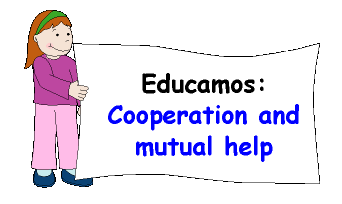|
The formation of this value is essential in peace education, since it is about men and women, boys and girls learning to work together with one another with the same aim. In order to lay the foundation of this value in the boys and the girls, it is necessary to teach them to do many and varied actions, such as to help one another, to know how to coordinate actions for a joint task, to help others to carry out a common aim, to feel collective joy for the achievement of a result, to defend their classmates and to help them when they face difficulties. Cooperation and mutual help have to be taught from the very first stages, because the child, due to his typical egocentrism tends to want everything for himself and not have to share it with anybody, but when he begins to carry out actions that benefit others, his initial egocentrism gives place to a gregarious and cooperating conduct. The reinforcement of an adult of the favourable behaviours to a relation of mutual help among children is one of the main elements in the emergence of emotions that accompany encounters, and the young child, in order to obtain the adult’s approval, shows little by little more and more of those behaviours that are reinforced to them as positive in their relations with others, such as mutual help. The model provided by the adult is another crucial element, because the child will tend to imitate what he sees the adults doing, so to the extent in which they favour cooperation and help to others, the child will tend to imitate those conducts at first, and then to develop them on his own. However, the educator’s daily work to form this value in children is not easy, and it requires a lot of patience and understanding, and at the same time a great knowledge of the children’s characteristics at this age. When the adult reinforces the behaviours of mutual help among the children, he encourages them to repeat them and to adopt them as part of their habitual behaviour. |
ACTIVITY
No 1 |
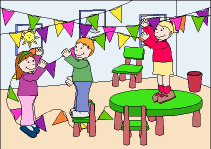 |
Summary of the activity: In the first two activities the children will work collectively to clean and decorate the classroom and the toys. In the third, they will make caps, decorations, bags for sweets and treats for the celebration for the children who turn years that month. The party will be the fourth activity. Objectives: Procedures: Scissors, glue, colour pencils, colour paper, cardboard, temperas, watercolours, stickers, rags to clean, bucket with water. Material
Resources:
Development of the activity: The tasks are distributed in small groups so that a group of boys and girls will clean the leaves of the plants, another one the shelves, a third one the toys, for example, each child will be given two or three toys to clean, to wash and dry and to put away, with everyone being responsible for a task. Another small group will organize the corners, etc. They can also run tasks where mutual cooperation is essential, like to move a small and light table, to lift the toy box, to organize the classroom, etc.
2nd Part When all the groups have finished, the educator together with the children will look around the classroom and will evaluate the work done. In order to help the children in this evaluation, he can ask them the following questions: what did they do? With whom? What is the result of the cleaning work? What has still to be done? etc. It is important that the usefulness of this work is emphasized, the help that has been given to the group and the importance of the cooperation and mutual help in benefit of all. He will also explain that through this work we can have a very pretty classroom and that it will be necessary that everybody cooperates so that the class always remains clean and pretty, for example: by not throwing papers or waste to the ground, cleaning and clearing our work table when we end an activity and in this way we will be helping the educator and the person who cleans our classroom.
3rd Part The educator will name the children who will be turning years in this month. The children, helped by the educator and distributed in small groups, will make decorations and little flags for the classroom; others will make invitation cards, greeting cards, bags for sweets, celebration caps, drawings, etc., gifts for the honoured ones and other things to be used in the party. The educator should distribute the tasks so that the children can obtain good results by coordinating their actions and giving help, for example, some cut out, others paste, others draw, etc. When the task is done, there will be an individual and collective evaluation guided by the educator, in which the children will express their criteria on the work done and where what was learned in this and in the previous activity on the importance of doing this type work with the help and cooperation of all will be consolidated. It is important that at the end of the activity the educator stresses that when we work together we can obtain very pretty things.
4th Part Once the party is over, we will talk with the parents and the children mainly about what they did for the successful accomplishment of this activity, an opportunity will be given to the children and the parents to express their ideas about everything they have done. |
CRITERIAL
ASSESSMENT |
|||
Observed
conduct |
YES |
NO |
Comments |
They
were able to coordinate their actions to complete the task. |
|||
They
fulfilled the assigned tasks until the end. |
|||
There
were conflicts during the completion of the tasks. |
|||
They
were glad with the results of their work. |
|||
They
understood the importance of cooperation and help. |
|||
ACTIVITY
No 2 |
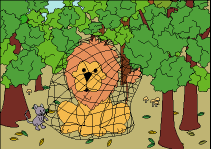 |
Summary of the activity: After reading a fable we will have a conversation with the children, during which they will answer the questions asked by the educator abount what happened to the characters of the fable. Later the children will talk about their experiences on the subject of cooperation and mutual help. Objectives: To develop in the children knowledge on the importance of mutual help and why it is necessary to live peacefully. Procedures:
Material Resources: Book of fables and pictures.
Development of the activity:
As he reads the story, the educator will show the pictures that he has prepared. 2nd
Part From the answers that the boys and girls give the educator will start a conversation with them on the importance of help, in this example it is possible to make comments on how the little mouse saved the life of a bigger and stronger animal, like the lion. How it was better for the lion to be peaceful with the little mouse. How important it is for everybody to live peacefully. To emphasize that even the most ferocious animals can live peacefully.
3rd Part It is important that the educator emphasizes the importance of giving help to live peacefully, and as in any given moment we can need help and receive it from someone we had not even imagined, as it happened to the lion of the fable. |
CRITERIAL
ASSESSMENT |
|||
Observed
conduct |
YES |
NO |
Comments |
They
understood the message of the fable. |
|||
They
expressed with their experiences that they have understood the importance
of help. |
|||
They
knew how to relate the importance of giving help to live peacefully. |
|||
They
suggested ways to help themselves mutually. |
|||
ACTIVITY
No 3 |
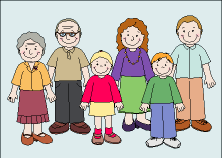 |
Summary of the activity: This is a role play with the argument of "The family" and the participants will be all the boys and girls who wish to take part in it. Objectives: To help the boys and girls to understand the need for the members of the family to help each other mutually in the household tasks. Procedures:
Material Resources: A play corner with all the necessary things for the children to play house or the family, that is: furniture, articles for the kitchen, cleaning articles, etc.
Development of the activity: In the course of this conversation the educator will ask the children questions so that they describe the role they are playing and guide them in the development of the household tasks in the family, and how they cooperate in them.
2nd Part
3rd Part Finally the educator will summarize the conversation stressing the need to help among the members of the family, so that everybody lives happily and peacefully. |
CRITERIAL
ASSESSMENT |
|||
Observed
conduct |
YES |
NO |
Comments |
They
carried the argument of the game to the end. |
|||
They
developed the actions corresponding to the role carried out, performing
actions of help and cooperation. |
|||
During
the interrelations with the other children in the game, they showed
gratefulness for the help received. |
|||
There
were conflicts arose during the game that were solved satisfactorily. |
|||
They
needed the educator’s help to solve the conflicts arisen during
the game. |
|||
ACTIVITY
No 4 |
Summary of the activity: This is a motion game in which the children will have to cross a circuit to help a hen and its chicks harassed by an evil fox. Objectives:
Procedures:
Material Resources: A wood plank, chalk to paint on the ground, dry leaves or branches of plants that do not offer danger for the children, a crate of approximately 40 or 50 cm. of height, bags of paper or fabric.
Development of the activity: There is a hen that is being harassed by a fox and she cannot go out to look for food for her small chicks. To solve this problem she asks the other animals of the corral for help. They must go through a very dangerous way, in order to hide from the fox and bring food for the chicks. The educator shows the children the circuit which they must go through and the actions that they will have to do to pass the obstacles that they are going to find. Next
he will tell the players the rules of the game:
2nd Part These roles will have to be alternated so that everyone can play a different character and do the different movements.
3rd Part
4th Part We will discuss the attitude of the fox because he did not let the hen live peacefully and take care of her chicks. |
CRITERIAL
ASSESSMENT |
|||
Observed
conduct |
YES |
NO |
Comments |
They
carried out the required motor actions. |
|||
They
needed much help to carry out the required motor actions. |
|||
They
showed joy and satisfaction in giving help. |
|||
They
were indifferent about giving help. |
|||
They
followed the rules of the game. |
|||
ACTIVITY
No 5 |
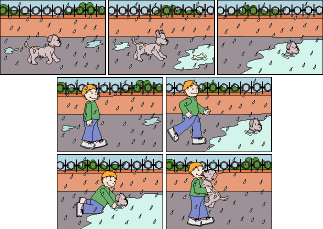 |
Summary of the activity: This is a game in which the child must order a series of cards with a specific sequence determined by the actions shown in them: They will make up a story about the cards later. Objectives: That the children recognize the value of helping others. Procedures:
Material
Resources: The educator can create any sequence of
actions, as long as in the same ones the need for help is illustrated.
It will have 7 cards (at most), for example:
Development of the activity: He
will explain the rules of the game that will be:
2nd Part To conclude the educator will emphasize the value of giving help at moments of hardship, if we helped ourselves and we did not fight, we would live peacefully and save many lives as the child who saved the dog. |
CRITERIAL
ASSESSMENT |
|||
Observed
conduct |
YES |
NO |
Comments |
They
ordered the cards correctly. |
|||
They
made up creative stories. |
|||
They
reflected the value of giving help in their stories. |
|||
ACTIVITY
No 6 |
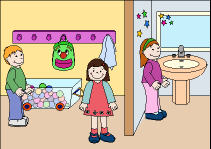 |
Summary of the activity: The children will take a stroll around the different rooms of the centre: classrooms and service areas, during it they will observe the work that the educational and service personnel carry out, they will talk with all the workers, finally the teacher will talk with the children about what they observed and listened to in the visit. Objectives: That the children know the usefulness of the work of the staff in their centre and how they can collaborate with these people. Procedures:
Material Resources: Photos can be taken of all the people who work in the centre carrying out their works.
Development of the activity:
2nd Part The children will observe the work of the service personnel who clean the center and talk with these workers to learn about the importance of this work and how it is necessary for the children to collaborate to keep their centre in order and clean. The children will observe how the educators take care of, attend to and teach the children of the younger groups and talk with them about how the older children can help the younger ones.
3rd Part |
CRITERIAL
ASSESSMENT |
|||
Observed
conduct |
YES |
NO |
Comments |
They
expressed and imitated in their games and activities what they observed
in the visit. |
|||
They
showed conducts of respect and cooperation towards other people's
work (to take care of the cleaning of the centre, etc.). |
|||
They
recognized the help that the workers from their school give to the
children. |
|||
ACTIVITY
No 7 |
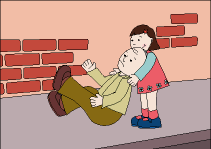 |
Summary of the activity: We will create a critical situation in which the children will portray characters that need help. Later they will answer the questions of the educator on how they would act in these situations. Objectives: To verify what the children have learnt about mutual help. Procedures:
Material Resources: A cane, dark glasses, a shirt with buttons, a toy.
Development of the activity:
2nd Part
3rd Part |
CRITERIAL
ASSESSMENT |
|||
Observed
conduct |
YES |
NO |
Comments |
They
knew how to give the necessary help in the different situations. |
|||
They
understood the need to help others to live peacefully. |
|||
They
developed spontaneous conducts to help others. |
|||
They
made comments on how to help those who need help. |
|||
They
showed cooperating conducts in the game and the daily activities of
the group. |
|||


